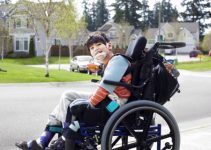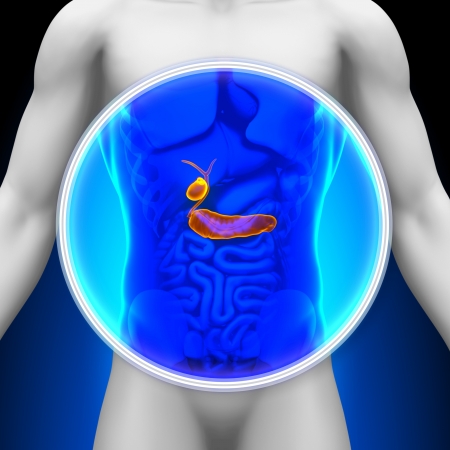Biliary Colic
Bile, a substance that helps in fat digestion, is produced at the liver and stored at the gallbladder. After a meal, bile is secreted from the gallbladder to the common bile duct where it goes into the small intestine and is mixed with partly digested food. An obstruction in its normal flow would cause spasms in the bile duct, an attempt to remove the cause of the blockage. This pain usually occurs a few hours after the consumption of a meal rich in fats and is termed biliary colic. The term “colic” is in fact misleading since the pain felt in this condition is not intermittent but felt steadily for at least fifteen minutes to an hour.
Gallstones
Gallstones are made up of bile salts and cholesterol. But researches have shown that these stones are more likely to be made of cholesterol that is formed when the liver starts to secrete bile covered with cholesterol. The cholesterol crystallizes and develops into stones which accumulate at the cystic duct or the gallbladder which can restrict the flow of bile. Most individuals with gallstones are usually asymptomatic and the presence of these stones is usually detected from diagnostics of other abdominal problems. Total obstruction could lead infection and every time bile is released, the ducts would need to contract more in order to remove the blockage – causing biliary colic.
Cholecystitis
Cholecystitis is the inflammation of the gallbladder mostly (95%) due to the presence of gallstones. The obstruction prevents the normal bile flow causing an infection and biliary colic. It can also be due to alcohol abuse, tumors or serious illness.
Biliary Colic Symptoms
An individual with biliary colic does not have fever but may have slight tachycardia due to the pain. There is right upper quadrant tenderness, dyspepsia, flatulence, nausea and vomiting. Protracted vomiting can result to dehydration. Symptoms of gallstones presence are not usually observed as most affected individuals are asymptomatic. Gallstones become troublesome only if cholecystitis is present or are lodged at the ducts causing duct spasms.
Gallbladder Pain
Abdominal pain is characterized by abdominal epigastric pain or right upper quadrant pain that is dull and visceral in source. The discomfort is poorly localized and may start at the epigastric region and radiates to the scapula or the right posterior shoulder. Acute pain is usually felt after a normal meal or fatty meal. Sometimes busy individuals tend to forget to eat and eating a large meal after a fast could trigger the biliary colic. Pain increases in frequency and intensity; and could last for an hour or more (usually six hours).
Biliary Colic Causes
There are many conditions that can cause biliary colic such as:
- Gallstones
- Cholecystitis which can be due to excess cholesterol or bilirubin in the bile
- Chronic acalculous gallbladder disease where the mechanism for gallbladder emptying is impaired.
- Cholangitis or the inflammation of the bile ducts
- Presence of polyps in the gallbladder
- Congenital defects of the bile ducts and gallbladder
- Tumors in the bile ducts and gallbladder
- Stenosis of the bile duct or sphincter of Oddi
- Pancreatitis
- Duodenitis
- Any injury to the gallbladder and bile ducts
Biliary Colic Tests
Biliary colic is only a symptom that is manifested by several other disease conditions, therefore differential diagnosis and careful evaluation should be made to determine the exact cause of the pain. This type of pain is the presenting symptom of about 80% of individuals with gallstone problems who obtain medical treatment.
CBC, Aspartate aminotransferase (AST), alkaline phosphatase, alanine aminotransferase (ALT), amylase, bilirubin analysis are normal if the patient has uncomplicated biliary colic and any abnormality would indicate complications such as cholecystitis, pancreatitis or cholangitis.
Abdominal ultrasound and x-rays would confirm the presence of gallstones and other abnormalities.
Biliary Colic Diet
Foods with high cholesterol and fats would trigger episodes of biliary colic therefore a low-cholesterol, low-fat diet should be maintained. Fat intake should not exceed 30 grams a day to help minimize gallstone formation. Increase the intake of high fiber foods also. Maintain also a bland diet since the spices can only irritate the gastrointestinal system.
Increase water intake as water is the most excellent means of flushing out toxins from the system. At least six to eight glasses of water a day are needed by the body to properly remove these toxins.
Biliary Colic Treatment
Conservative treatment includes bed rest until the resolution of pain. Recurrent pain is treated with NSAIDs and analgesics. NSAIDs may also help decrease the inflammation. Anti-spasmodics are also given to relax the gall bladder and the bile ducts and prevent them from contracting too much, relieving the pain. If protracted vomiting occurs, IV fluids may be started to help maintain fluid balance and prevent dehydration. Anti-emetics may also be given to prevent further vomiting. Medications to dissolve the gallstones may be given such as Ursodiol (Actigall) and Chenodiol (Chenix) but this would take months of therapy before all the stones will be dissolved. In cases of cholecystitis, antibiotics are started.
In the event when conservative treatments will not relieve the pain, then surgical removal of the gallstones or gallbladder (laparoscopic cholecystectomy) may be needed to prevent recurrence of attacks. Cholecystotomy or biliary drainage may also be done to remove stones and fluids from the gallbladder. Another way to remove the stones is through lithotripsy where shock waves are introduced to the body to break the stones making it easy to expel them. In cases where stenosis of the ducts is the problem, stenting is done to help keep these ducts open.
Biliary Colic Prevention and Prognosis
Biliary colic usually resolves itself once the irritants in the gallbladder are removed. Adherence to the proper treatment therapy and maintaining a healthy weight, proper diet and exercise would help prevent the occurrence of biliary colic.
References:
http://emedicine.medscape.com/article/171256-overview
http://www.patient.co.uk/doctor/Gallstones-and-Cholecystitis.htm
http://www.merckmanuals.com/home/sec10/ch140/ch140b.html
http://www.drugs.com/cg/biliary-colic-aftercare-instructions.html


